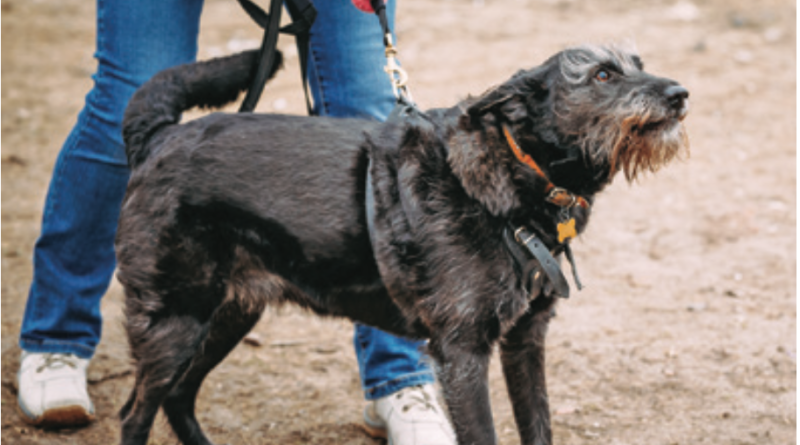Why Do Dogs Growl at People
Although your dog seems to be fine with visitors to your home, you’ve noticed that she’s become increasingly aggressive toward people who approach the two of you when she’s on her leash. For example, the other day it was a nice sunny morning, you were walking your dog through your neighborhood when a new neighbor, out for her morning stroll, approached you.
“What a cute dog!” she exclaimed. Before you could stop her, she bent over and reached for your dog, only to have your beloved canine pal growl and lunge at or – shudder – perhaps even bite her human admirer. What just happened there? Was your dog protecting you?
It’s possible, but it’s far more likely that your dog was manifesting defensive fear-related aggression.
Is My Dog Protecting or Defending Me?
I see an average of a dozen clients a month who come to me because of concerns about their dogs’ aggressive behaviors. At some point during our consultation at least half of them suggest that their dog is trying to protect them. I suspect it might secretly make them feel better to think their dog is looking out for their best interests, even if it manifests as an undesirable behavior that risks the well-being of the dog as well as the person on the receiving end of the aggression. Sadly, dogs who bite people tend to lose their homes, if not their very lives.
I tell my clients that a far more likely explanation is that their dog is being defensively aggressive. She is probably a little cautious around (or even overtly fearful of) strangers.
Escape is usually the first behavior choice for a fearful dog, but if she’s on a leash and can’t retreat, she communicates in the only way she knows to tell the scary person to stay away. Growl. Lunge. Snap. Bite.
We often see this behavior emerge in dogs during adolescence, as they approach maturity. Most of my clients with these concerns have dogs who are from eight to 18 months of age. These are usually the dogs who were somewhat shy as a pup. Shy pups tend to shut down and suffer the attentions of the people who want to greet or comfort them. As they get a little older, they may respond with a growl instead of just shutting down.
Wise people back off when a dog growls. “Hey!” the dog learns. “That worked; I’m going to try that again!” The growling behavior is reinforced by success; the dog realizes that she can get people to leave her alone by growling at them, so she growls more when people approach. At some point when an approaching stranger doesn’t react quickly enough to growling, she escalates to a lunge. That works, too. Lunge, snap, and perhaps even bite are added to the behavioral repertoire.
Are Dogs Truly Protective?
Do dogs without training ever truly protect their humans? It does happen, but it’s rare. In many years of working with dogs, I’ve heard about this happening only once.
Years ago, one of my friends/co-workers at the Marin Humane Society adopted an outgoing, people-loving, medium-sized mixed-breed dog from our shelter, Sparky, who had never dreamed of biting a human in his life. One evening as my friend was walking with Sparky, they were confronted by a mugger with a gun, who demanded my friend’s fanny pack, which contained her wallet. Sparky launched himself at the mugger and was shot as a result, but the mugger took off leaving my friend unharmed and in possession of her fanny pack and all her valuables therein. And Sparky recovered from his injuries and continued to be a friend to every other human he met for the rest of his life.
So, it can happen – but it’s unlikely that’s what your dog is doing.
Protection Dog Training

Photo Credits: Jaromir Chalabala / Dreamstime.com
Perhaps you want your dog to be protective. Some people hope that their canine family member will serve as some degree of protection, and sometimes, randomly adopted dogs often do. Many humans with ill intentions will steer clear of any person with a dog, not wanting to risk a possible encounter with an unfriendly canine. Homes where dogs live (especially vocal dogs) are less likely to be burgled for the same reason. That’s different, however, from the dog who is purposely trained or encouraged to be aggressive toward threatening people.
Protection training is a very precise and careful process, starting with a dog who is exceptionally well-adjusted and well-socialized. You don’t want a dog who is driven by fear or suspicion making poor decisions about who to attack!
At the simplest level of protection training, dogs are simply taught to bark on cue. You can do this yourself. It doesn’t even have to be an aggressive bark – someone approaching you with evil intentions will be put off by a dog barking – they’re not likely to stop and try to analyze canine body language to determine if your dog really might bite them.
Your cue should be a word or phrase that doesn’t tip off the person but might be natural in the situation. It could be “What do you want?!” in a slightly alarmed tone of voice – something you might say to a suspicious person approaching you. Alternatively or additionally the cue to bark could be an even more subtle signal that your dog would notice but the other person probably would not, such as a fake sneeze, an upward tug on the leash (assuming you don’t normally tug up on your dog’s leash), or whatever makes sense to you. Once you’ve taught your dog to bark on cue, simply cue her to bark if someone is approaching who makes you uncomfortable.
I would suggest you stop there. The mainstream dog-loving population doesn’t really need a dog to be a fang-flashing deadly weapon, and the responsibility and liability of caring for a protection-trained dog is huge. If you do have a legitimate need for a trained protection dog, be sure to seek out the services of a reputable protection-dog trainer. We recommend force-free training, but if a trainer is not force-free, at a minimum, we’d hope the candidate trainer honestly and assiduously follows the least invasive, minimally aversive (“LIMA”) principles espoused by professional organizations such as the Association for Professional Dog Trainers and the Certification Council for Professional Dog Trainers.
DEFENSIVE AGGRESSION
Assuming your dog is being defensively aggressive, not really protecting you, what can you do about it?
You can manage her behavior, of course, by keeping her safe at home where she’s not going to be approached by someone who makes her uncomfortable. However, a lot of people adopt dogs because they enjoy taking them for walks. If this is true for you, you can manage by stopping anyone from approaching and trying to pet her, especially when you are walking her on leash.
You need to be brusque and assertive for this to work. By the time you politely say, “Please don’t approach my dog, she’s really not comfortable with strangers,” she could have already bitten the rapidly advancing dog-lover. Instead, hold your hand up, chest high and palm forward in the universal “stop” signal, and say “Stop!” in a loud, assertive tone. Now you have time to explain why you don’t want them to pet your dog. Stick to your guns, even if you get the standard “But dogs love me!” assurance.
Of course, it’s even better if you can convince your dog she doesn’t have to be fearful of people she doesn’t know. Classical counter-conditioning and desensitization is very useful here: Consistently pair the presence of strangers with very high-value treats (we use chicken – baked, boiled, or the unseasoned frozen chicken strips you can find in your grocer’s freezer) while keeping your dog far enough away that she’s aware of their presence but not overly concerned. Strangers make treats happen!
If she won’t take the treats, or if she’s growling, barking, or lunging, you are too close! Let her look, then feed her a treat. Look, treat. Look, treat. When she no longer seems concerned about the person, move slightly closer and repeat the procedure. Take your time. If you think you’re going too slow, slow down.
Another very useful procedure is “Treat and Retreat.” This one is nice because you can employ the assistance of the dog-loving stranger and fulfill her desire to interact with your dog in a safe way way while you are also helping your dog become more comfortable with strangers.
What you don’t want to do is have the scary stranger feed your dogs treats from their hand. While this seems like a feasible version of counter-conditioning (strangers make treats happen), it often draws the dog too close to the person (because she really wants the treat) and then when the treat is gone, she looks up to see the scary stranger right in her face, and wham! The bite happens.
Another thing you don’t ever want to do is punish your dog for her defensive behavior: no verbal or physical corrections, no squirt bottles, no yanking on the leash, no bean bags. While punishment may stop the behavior in the moment, these aversive methods are very likely to increase your dog’s stress, defensiveness, and aggression in the future when people approach; now she has to worry about what you’re going to do as well as what the stranger may do. Our goal is to have her associate good stuff with strangers, not bad stuff. We want her to feel better about people approaching, not worse!
How to Play the Treat and Retreat Game

In order to play the Treat and Retreat game, you must have some tasty high-value treats, a dog leash (for safety, if you don’t trust your dog around people) volunteers, and a basic knowledge of canine signs of stress. If you want to play it safe, you can enlist the aid of a force-free dog behavior professional to show you how to do the initial work. Here’s how to carry out this behavior-altering game:
1. Arm your volunteers with a supply of kibble and a second bag of tasty, high-value, bite-sized treats.
2. Tell your volunteers to avoid making direct eye contact with your dog when they meet her, as many dogs find this threatening.
3. Upon meeting your dog, in your home or elsewhere, have your volunteer toss a high-value treat past the dog. This way your dog gets to retreat to get the treat.
4. Repeat many times with different people and at different times of the day, in different locations.
5. Once your dog is enjoying the procedure, it’s time to raise criteria. Have a volunteer toss the higher-value treat between herself and your dog (but very close to the dog) so the dog must move closer to the person. Then right afterward toss a lower-value treat (the kibble) past the dog.
6. Repeat with different people at different times of the day in different locations.

7. When your dog is clearly enjoying this game, you can further raise criteria. Have a volunteer gradually toss treats closer to herself so the dog comes closer (then toss one far away so the dog can retreat).
8. Repeat with different volunteers, different times of the day, in different locations until the dog is consistently more relaxed and starts taking more initiative in happily greeting people. As long as your dog is now happily approaching the volunteer with relaxed body language, soft eyes, and wagging tail, you can move to the next step. If not, go back to Step 6.
9. Eventually – and only as long as your dog is relaxed and comfortable with your volunteer –allow the person to hand-feed the higher-value treat to your dog, and right afterward, toss a lower-value treat (the kibble) past the dog.
It’s worth taking the time and making the effort to help your defensive dog become more comfortable with approaching strangers. The less stress in her life (and yours), the better the quality of life for both of you. The less stressed she is about encounters with strangers, the less likely an unfortunate incident will occur at some point in her future, and the more likely the two of you will be able to enjoy a long and happy life together.





overseas pharmacies shipping to usa https://canadadrugs.pro/# – canada drugs canadadrugs.pro
mail order pharmacy https://canadadrugs.pro/# – pain meds online without doctor prescription canadadrugs.pro
top 10 online pharmacy in india https://medicinefromindia.store/ indian pharmacy
buy cytotec pills https://cytotec24.com/ buy cytotec over the counter
diflucan 200 mg cost https://diflucan.pro/ diflucan 15 mg
buy nolvadex online https://nolvadex.guru/ tamoxifen and weight loss
Abella Danger https://abelladanger.online/ abella danger video
play aviator: https://aviatorghana.pro/ aviator game bet
aviator bet https://aviatorjogar.online/ – aviator bet
sweet bonanza taktik https://sweetbonanza.bid/ – sweet bonanza mostbet
pin up aviator: https://pinupgiris.fun/ aviator pin up
medication from mexico pharmacy: best mexican online pharmacies mexican online pharmacies prescription drugs mexicanpharmacy.shop